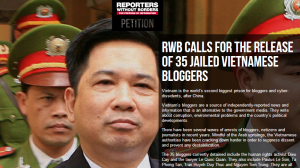
Chinese dredging vessels are purportedly seen around Fiery Cross Reef in the disputed Spratly Islands in the South China Sea in this image from video taken by a P-8A Poseidon surveillance aircraft provided by the U.S. Navy, May 21, 2015.
China’s sweeping claims of jurisdiction over the South China Sea were rejected last month by an international tribunal in The Hague, but the Chinese government has worked to defy that ruling with diplomatic maneuvers, assertive rhetoric and propaganda
VOA, August 07, 2016
NEW YORK— China’s sweeping claims of jurisdiction over the South China Sea were rejected last month by an international tribunal in The Hague, but the Chinese government has worked to defy that ruling with diplomatic maneuvers, assertive rhetoric and propaganda.
One example of China’s version of the South China Sea dispute has been on spectacular display for most of the past two weeks — a video playing 120 times per day on a huge screen in New York City’s famed Times Square.
Chinese state media say the three-minute video message is targeting a “global audience” — in this case, the 350,000 tourists and New Yorkers who pass through Times Square every day — with the message that China “has indisputable sovereignty” over the South China Sea.
The Chinese video appears on a 200-square-meter screen high above Times Square, one of the most prominent locations on an enormous advertising display that covers one entire side of the building known as 2 Times Square.
VOA reporters went to Times Square on Wednesday, the next-to-last day of the Chinese video’s 12-day run, to ask onlookers what they thought of the display, and the South China Sea issue. It turned out most of the visitors they spoke with had not even noticed the South China Sea message.
Outdazzled in venue
The three-minute video, partly in Chinese, is filled with earnest discussion of the serious geopolitical issues involved, and it certainly is outdazzled by the gleaming, flashing array of huge LED screens on all sides, sending out commercial messages for all sorts of services, products and entertainment media.
The South China Sea video appeared around the clock from July 23 to August 3 on a screen that has been leased by Xinhua, China’s official news agency, since 2011. The New York Times estimates the Chinese pay between $300,000 and $400,000 per month in rental fees.
A tourist named Josh, sitting on some steps directly below the Xinhua display, confessed he hadn’t noticed the display. Near Josh and a companion was Hannah, a South Korean tourist, who said she did not even know the video from Beijing was playing high above the street.
The VOA reporters kept pointing out the video screen to people who had no idea it was there — so much that they felt they were acting like free tour guides representing Xinhua.
China is trying to save face, both at home and abroad, after the Permanent Court of Arbitration ruled on July 12 that Beijing violated international law when it seized and damaged submerged reefs off the coast of the Philippines.
Chinese media say “it is time to let the world understand the truth [about] the South China Sea,” and that the video message is helping to correct “falsehoods” arising from the ruling in The Hague.
Yet the Chinese video itself has been accused of spreading falsehoods. It prominently features a British member of Parliament, Catherine West of the Labor Party, quoting some of her past remarks about tensions surrounding the South China Sea in a way that suggests she is fully behind Beijing’s position.
West disagrees, and says she was quoted out of context, because she has “consistently raised concern over Chinese island-building and military deployment in the South China Sea.”
British correspondents also have pointed out that another staunch supporter of Beijing’s viewpoint appearing in the video is identified as John Ross, “a former policy director of economic and business policy of London.” He is perhaps more accurately described as a fellow at China’s Renmin University who has defended China’s human-rights record, a frequent contributor to the state-owned China Daily and a former leader of an international Marxist group.
Back to the tourists in Times Square. Two South Korean visitors, JP and Mosey, were puzzled when they learned that China has been renting the giant LED screen to play political messages.
“That must be expensive, right?” Mosey asked. To them it seemed like only large companies paid such high prices for advertising. JP pointed at another display featuring one of South Korea’s most well-known brands, saying, “Samsung! Samsung!”
A tourist visiting New York from China seemed unimpressed by the video. “This is for local people to see,” he told the VOA reporters, because “it is in English.” (Actually, there are a number of subtitles and captions in Chinese.)
Unimpressed
Li, a Chinese tourist from Canada, did not seem particularly interested in the matter. He said he doesn’t particularly follow Chinese news, or the problems in the South China Sea.
Several tourists said they felt China’s message would have been more effective if it was played for diplomats at United Nations headquarters, just a kilometer or two away from Times Square.
Harvey, a French father leading his family around New York, said China should have answered the international arbitration court’s ruling in a more appropriate forum. “Here, you look up and there’s a lot of advertising,” he said. “There are too many other things mixed in there with the important things so the message is unclear.”
Times Square’s promoters have used the slogan “crossroads of the world” to describe that section of midtown Manhattan for decades, long before digital technology and riotous displays amplified the dizzying effect of commercial advertising to the current level.
With so much competition for the attention of passersby, even strong political propaganda can be overwhelmed and disappear without a trace.
Height Insoles: Hi, I do believe this is an excellent site. I stumbledupon …
http://fishinglovers.net: Appreciate you sharing, great post.Thanks Again. Keep writi…
Achilles Pain causes: Every weekend i used to pay a quick visit this site, as i w…






August 8, 2016
China Airs Propaganda Video Over New York’s Times Square
by Nhan Quyen • [Human Rights]
Chinese dredging vessels are purportedly seen around Fiery Cross Reef in the disputed Spratly Islands in the South China Sea in this image from video taken by a P-8A Poseidon surveillance aircraft provided by the U.S. Navy, May 21, 2015.
VOA, August 07, 2016
NEW YORK— China’s sweeping claims of jurisdiction over the South China Sea were rejected last month by an international tribunal in The Hague, but the Chinese government has worked to defy that ruling with diplomatic maneuvers, assertive rhetoric and propaganda.
One example of China’s version of the South China Sea dispute has been on spectacular display for most of the past two weeks — a video playing 120 times per day on a huge screen in New York City’s famed Times Square.
Chinese state media say the three-minute video message is targeting a “global audience” — in this case, the 350,000 tourists and New Yorkers who pass through Times Square every day — with the message that China “has indisputable sovereignty” over the South China Sea.
The Chinese video appears on a 200-square-meter screen high above Times Square, one of the most prominent locations on an enormous advertising display that covers one entire side of the building known as 2 Times Square.
VOA reporters went to Times Square on Wednesday, the next-to-last day of the Chinese video’s 12-day run, to ask onlookers what they thought of the display, and the South China Sea issue. It turned out most of the visitors they spoke with had not even noticed the South China Sea message.
Outdazzled in venue
The three-minute video, partly in Chinese, is filled with earnest discussion of the serious geopolitical issues involved, and it certainly is outdazzled by the gleaming, flashing array of huge LED screens on all sides, sending out commercial messages for all sorts of services, products and entertainment media.
The South China Sea video appeared around the clock from July 23 to August 3 on a screen that has been leased by Xinhua, China’s official news agency, since 2011. The New York Times estimates the Chinese pay between $300,000 and $400,000 per month in rental fees.
A tourist named Josh, sitting on some steps directly below the Xinhua display, confessed he hadn’t noticed the display. Near Josh and a companion was Hannah, a South Korean tourist, who said she did not even know the video from Beijing was playing high above the street.
The VOA reporters kept pointing out the video screen to people who had no idea it was there — so much that they felt they were acting like free tour guides representing Xinhua.
China is trying to save face, both at home and abroad, after the Permanent Court of Arbitration ruled on July 12 that Beijing violated international law when it seized and damaged submerged reefs off the coast of the Philippines.
Chinese media say “it is time to let the world understand the truth [about] the South China Sea,” and that the video message is helping to correct “falsehoods” arising from the ruling in The Hague.
Yet the Chinese video itself has been accused of spreading falsehoods. It prominently features a British member of Parliament, Catherine West of the Labor Party, quoting some of her past remarks about tensions surrounding the South China Sea in a way that suggests she is fully behind Beijing’s position.
West disagrees, and says she was quoted out of context, because she has “consistently raised concern over Chinese island-building and military deployment in the South China Sea.”
British correspondents also have pointed out that another staunch supporter of Beijing’s viewpoint appearing in the video is identified as John Ross, “a former policy director of economic and business policy of London.” He is perhaps more accurately described as a fellow at China’s Renmin University who has defended China’s human-rights record, a frequent contributor to the state-owned China Daily and a former leader of an international Marxist group.
Back to the tourists in Times Square. Two South Korean visitors, JP and Mosey, were puzzled when they learned that China has been renting the giant LED screen to play political messages.
“That must be expensive, right?” Mosey asked. To them it seemed like only large companies paid such high prices for advertising. JP pointed at another display featuring one of South Korea’s most well-known brands, saying, “Samsung! Samsung!”
A tourist visiting New York from China seemed unimpressed by the video. “This is for local people to see,” he told the VOA reporters, because “it is in English.” (Actually, there are a number of subtitles and captions in Chinese.)
Unimpressed
Li, a Chinese tourist from Canada, did not seem particularly interested in the matter. He said he doesn’t particularly follow Chinese news, or the problems in the South China Sea.
Several tourists said they felt China’s message would have been more effective if it was played for diplomats at United Nations headquarters, just a kilometer or two away from Times Square.
Harvey, a French father leading his family around New York, said China should have answered the international arbitration court’s ruling in a more appropriate forum. “Here, you look up and there’s a lot of advertising,” he said. “There are too many other things mixed in there with the important things so the message is unclear.”
Times Square’s promoters have used the slogan “crossroads of the world” to describe that section of midtown Manhattan for decades, long before digital technology and riotous displays amplified the dizzying effect of commercial advertising to the current level.
With so much competition for the attention of passersby, even strong political propaganda can be overwhelmed and disappear without a trace.